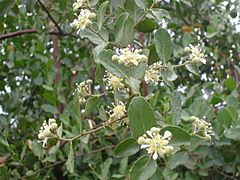Quillajaceae facts for kids
Quick facts for kids Quillaja family |
|
|---|---|
 |
|
| Quillaja saponaria | |
| Scientific classification | |
| Kingdom: | |
| Division: | |
| Class: | |
| Order: | |
| Family: |
Quillajaceae
D.Don. (1831)
|
| Synonyms | |
|
Spiraeoideae tribus Quillajeae |
|
The Quillajaceae family is a small group of flowering plants. It includes just two known species: Quillaja saponaria and Quillaja brasiliensis. These plants were once thought to be part of the Rosaceae family, which includes roses and apples. Now, scientists know they are different enough to have their own family.
Contents
What Are Quillaja Plants?
Quillaja plants are trees that can grow quite tall. They are known for their special bark. This bark contains natural chemicals called saponins. Saponins are like natural soap. When you mix them with water, they create a foamy lather. This is why Quillaja saponaria is often called the "soap bark tree."
The Soap Bark Tree
Quillaja saponaria is the most famous species in this family. It is a medium-sized evergreen tree. This means it keeps its leaves all year round. The tree has shiny, oval-shaped leaves. It also produces small, white flowers. These flowers grow in clusters.
How Saponins Work
Saponins get their name from the word "sapo," which means soap. They are found in many plants. In Quillaja trees, saponins help protect the plant. They can make the plant taste bitter to animals. They also help the plant fight off germs. For humans, saponins are useful because they can clean things.
Where Do Quillaja Plants Grow?
Both species of Quillaja are native to South America. They grow naturally in specific regions.
Quillaja saponaria Habitat
Quillaja saponaria is mostly found in Chile. It grows in the central part of the country. This area has a Mediterranean climate. This means it has warm, dry summers and mild, wet winters. The trees often grow on hillsides and in dry forests. They are very tough plants. They can survive in poor soil and dry conditions.
Quillaja brasiliensis Habitat
Quillaja brasiliensis grows further north. It is found in Brazil, Argentina, and Uruguay. This species prefers slightly different conditions. It often grows in grasslands and open woodlands. Both species are important parts of their local ecosystems.
Amazing Uses of Quillaja
Quillaja trees have been used by people for a very long time. Their unique properties make them valuable.
Traditional Uses
Native people in South America used Quillaja bark for many purposes. They used it as a natural soap for washing clothes. They also used it to wash their hair and bodies. The bark was also used in traditional medicine. It was thought to help with coughs and other breathing problems.
Modern Applications
Today, Quillaja extract is still very useful. It is used in many different products.
- Food and Drinks: Quillaja extract is used as an emulsifier. This means it helps mix oil and water. It can make drinks like root beer foamy. It also helps keep ingredients blended in some foods.
- Cosmetics: Because of its soap-like qualities, it is found in some shampoos and soaps. It can also be in skincare products.
- Vaccines: A special part of Quillaja extract is used in some vaccines. It helps make the vaccine work better. It boosts the body's immune response. This means the body learns to fight off diseases more effectively.
- Fire Extinguishers: The foaming properties of Quillaja extract are even used in some fire-fighting foams.
Images for kids
See also
 In Spanish: Quillajaceae para niños
In Spanish: Quillajaceae para niños



